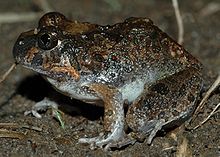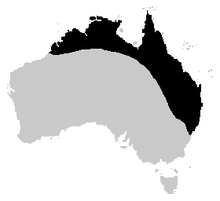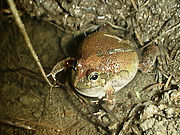- Ornate Burrowing Frog
-
Ornate Burrowing Frog 
Conservation status Scientific classification Kingdom: Animalia Phylum: Chordata Class: Amphibia Order: Anura Family: Myobatrachidae Subfamily: Limnodynastinae Genus: Opisthodon Species: O. ornatus Binomial name Opisthodon ornatus
Gray, 1842
Range of the Ornate Burrowing Frog (Opisthodon ornatus). Synonyms Limnodynastes ornatus
Günther, 1859The Ornate Burrowing Frog (Opisthodon ornatus) formerly (Limnodynastes ornatus) is a species of ground frog native to Australia. It was moved to the genus Opisthodon in 2006 following a major revision of amphibians [1].
Contents
Physical description
This frog is a relatively small and stubby species, growing no larger than 50 mm. It ranges in colour from grey to brown to yellow, and the dorsal surface patterns vary greatly between specimens. There is usually a butterfly-shaped patch behind the eyes. The dorsum is generally covered with red-tipped warts, and skin folds are present towards the head. The legs and arms are barred or spotted with darker markings. Toes have a slight webbing, while fingers have none.
Ecology and behaviour
This species distribution ranges from western Sydney to Cape York in Queensland, running along either side of the Great Dividing Range across to Western Australia. It occurs in both wet sclerophyll forest in coastal areas and in woodland in more arid regions. As its name suggest, this species of frog burrows. It burrows feet first, enlarged tubecles on the frogs feet help them in scraping out soil. This species is usually only seen after heavy rain during spring or summer. Males call while floating in still water bodies such as dams, puddles and flooded grassland. The call is a short, nasal "unk" repeated slowly.
Breeding
Breeding occurs only after heavy rain. Up to 1600 eggs are deposited in a small, dome shaped foam mass that soon collapses into a single floating film layer of eggs and jelly. Tadpoles reach 50mm but commonly only reach 36 mm in length. The dorsum is a dusky grey or brown. The side of the body has silver and/or gold flecking and the tail has grey-silver flecks.
Similar species
This species looks very similar to Spencer's Burrowing Frog, Opisthodon spenceri and some Neobatrachus species. It is distinguished from all of these species by the reduced webbing and mating call.
References
- Anstis, M. 2002. Tadpoles of South-eastern Australia. Reed New Holland: Sydney.
- Barker, J.; Grigg, G.C.; Tyler, M.J. (1995). A Field Guide to Australian Frogs. Surrey Beatty & Sons.
Footnotes
- ^ BirdLife International (2008). Platyplectrum ornatum. In: IUCN 2008. IUCN Red List of Threatened Species. Downloaded on 24 February 2010.
External links
- Frogs Australia Network-frog call available here.
Categories:- IUCN Red List least concern species
- Amphibians of Queensland
- Amphibians of New South Wales
- Amphibians of the Northern Territory
- Amphibians of Western Australia
- Myobatrachidae
- Animals described in 1842
Wikimedia Foundation. 2010.


